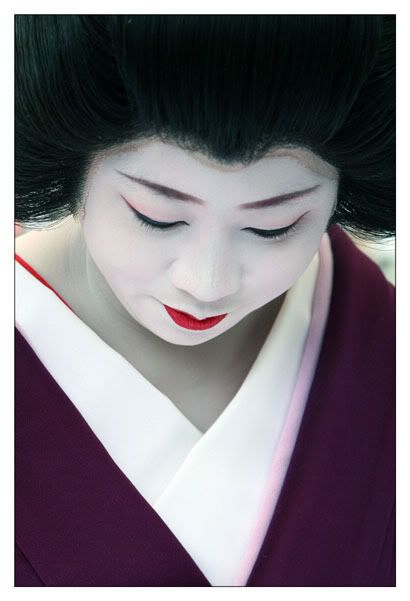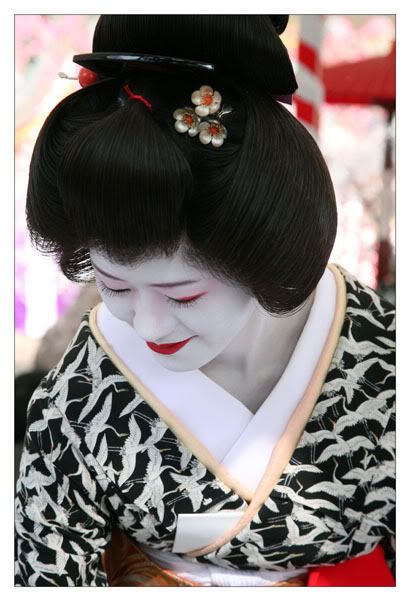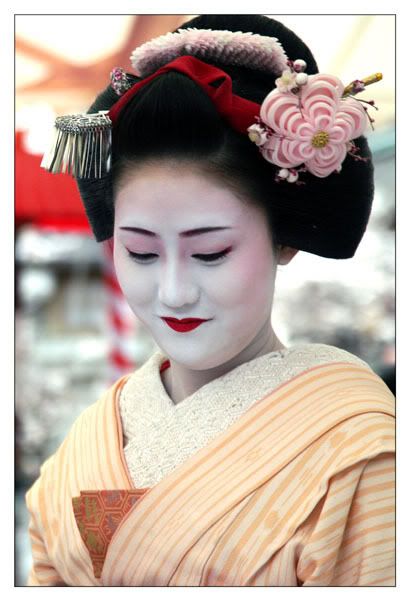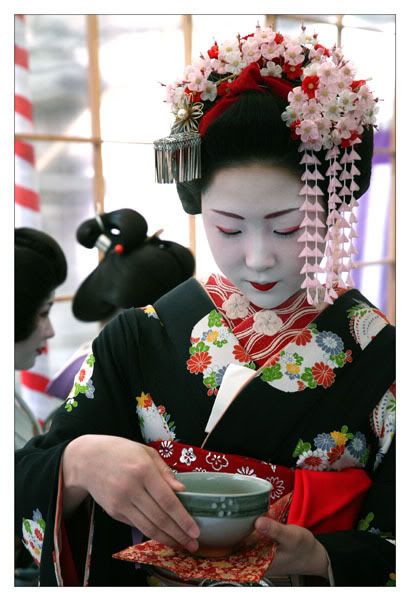
Naohiro, geiko of Kamishichiken.
Kitano Tenmangu Shrine's famous Baikaisai, or Plum Blossom Festival, is held every February 25th in memory of the deified patron saint of scholarship, Sugawara Michizane, a Heian Era court official and avid plum blossom admirer. After graduating from the national academy, he began his ill-fated career at court as a scholar. Although he was elevated in rank under the grace of Emperor Uda, his rivalry with a member of the powerful Fujiwara family resulted in his banishment from court. Demoted to the rank of a minor official in Kyushu, he died a lonely death with a dishonored name.
 Plum blossoms in full bloom beneath the brightly covered eves of Kitano Tenmangu Shrine.
Plum blossoms in full bloom beneath the brightly covered eves of Kitano Tenmangu Shrine.
After his death, plague and drought spread throughout the capital. The emperor's sons began to die in rapid succession. The Imperial Palace's Great Audience Hall (shishinden) was repeatedly struck by lightning as the city was drenched by rainstorms and floods. Attributing this to the angry spirit of the exiled Sugawara, the imperial court built and dedicated Kitano Tenmangu shrine to him, posthumously restoring his title and office. All mention of his exile was struck from the record and Sugawara was deified as Tenjin-sama, or kami of scholarship. Today many Shinto shrines in Japan are dedicated to him.
Umeshizu prepares to perform the tea ceremony.
I never really got around to uploading many of the pictures I took at last year's Baikasai, and since I can't be there this year, I'd like to share these with you now. Enjoy! "Living flowers" beneath the plum blossoms. From right to left: Umesato, Naokazu, Satoyuki, and Naohiro.
"Living flowers" beneath the plum blossoms. From right to left: Umesato, Naokazu, Satoyuki, and Naohiro.
Katsuya leads her younger sister to the grounds of Kitano Tenmangu shrine.
The breath-takingly beautiful Umeha.
Naokazu and Satoyuki. Katsuya smiles as she serves guests.
Katsuya smiles as she serves guests.
Satoyuki took part in the 2007 Baikasai as part of her training to become a geisha. She did not make her debut until afterwards. I was captivated by her stunning M.C. Escher-esque kimono.
Umeshizu gently smiles before offering a cup of matcha, a bitter powdered green tea whipped to frothy perfection, to guests.
The elegant Naozome, a high ranking maiko, never fails to make an impression.
Katsuryu concentrates on correct ettiquette as she serves the guests during her first Baikasai. She had only made her debut as a maiko earlier that month.
Satoyuki smiles.
Umeha and Naohiro in shades of lavender and plum.
Umeha laughs.
Tamayuki is a senior geiko of the Kamishichiken district. As geiko grow in experience and skill, they rely less on their flashy kimonos, hair, and make-up, and more on their skill, which is where there true beauty lies.
Katsuryu: Can you say KAWAII! So cute!
Naozome and Ichiteru.
Katsue in her final appearance as a maiko at the annual Baikasai. Now a geiko, she will soon be performing in the Kitano Odori as a full-fledged geisha.
Ichifumi, the famous blogging maiko Ichimame's little sister, laughing with guests during her first Baikasai.
Yasunari Kawabata, the first Japanese to win the nobel prize (1968) once wrote "If for no other reason than to preserve traditional hairstyles, the geisha's existance is vital. I wonder how and when these hairstyles developed."
"Japanese men, as a rule, feel about a woman's neck and throat about the same way as men in the west feel about a woman's legs. This is why geisha wear the collars of their kimono so low in the back...I suppose that its like a woman in Paris wearing a short skirt."
~Sayuri, in 'Memoirs of a Geisha' by Aurthur Golden.
Ichimame laughs as she entertains guests.
Sisters Ichimame and Ichifumi admiring the plum blossoms.














